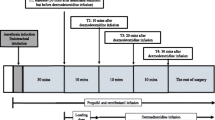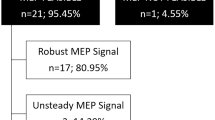Abstract
Remimazolam is a short-acting benzodiazepine that was approved for clinical use in 2020. We report three patients who underwent surgery for cerebral and spinal cord tumors, in whom transcranial electrical stimulation-motor-evoked potential (TES-MEP) was successfully monitored under general anesthesia with remimazolam. During total intravenous anesthesia with propofol at a target concentration of 2.7 − 3.5 µg/mL and 0.1 − 0.35 µg/kg/min of remifentanil, delayed awakening, bradycardia, and hypotension during propofol anesthesia were expected in all three cases. With patient safety as the top priority, we considered changing the anesthetic agent. Propofol was replaced with remimazolam at a loading dose of 12 mg/kg/h for a few seconds (case 3), followed by 1 mg/kg/h for maintenance (cases 1–3). TES-MEP was recorded during propofol and remimazolam administration in all three patients. Amplitudes of TES-MEP during anesthesia with propofol and remimazolam were 461.5 ± 150 µV and 590.5 ± 100.9 µV, 1542 ± 127 µV and 1698 ± 211 µV, and 581.5 ± 91.3 µV and 634 ± 82.7 µV sequentially from Case 1. Our findings suggest that intraoperative TES-MEP could be measured when anesthesia was managed with remimazolam at 1 mg/kg/h.



Similar content being viewed by others
Change history
30 November 2022
A Correction to this paper has been published: https://doi.org/10.1007/s00540-022-03146-4
References
Taniguchi M, Cedzich C, Schramm J. Modification of cortical stimulation for motor evoked potentials under general anesthesia: technical description. Neurosurgery. 1993;32:219–26.
Kombos T, Suess O, Ciklatekerlio Ö, Brock M. Monitoring of intraoperative motor evoked potentials to increase the safety of surgery in and around the motor cortex. J Neurosurg. 2001;95:608–14.
Talacchi A, Turazzi S, Locatelli F, Sala F, Beltramello A, Alessandrini F, Manganotti P, Lanteri P, Gambin R, Ganau M, Tramontano V, Santini B, Gerosa M. Surgical treatment of high-grade gliomas in motor areas. The impact of different supportive technologies: a 171-patient series. J Neurooncol. 2010;100:417–26.
Rampil IJ, King BS. Volatile anesthetics depress spinal motor neurons. Anesthesiology. 1996;85:129–34.
Kerz T, Hennes HJ, Fève A, Decq P, Filipetti P, Duvaldestin P. Effects of propofol on H-reflex in humans. Anesthesiology. 2001;94:32–7.
Pelosi L, Stevenson M, Hobbs GJ, Jardine A, Webb JK. Intraoperative motor evoked potentials to transcranial electrical stimulation during two anaesthetic regimens. Clin Neurophysiol. 2001;112:1076–87.
MacDonald DB, Skinner S, Shils J, Yingling C. American Society of Neurophysiological Monitoring. Intraoperative motor evoked potential monitoring–A position statement by the American Society of Neurophysiological Monitoring. Clin Neurophysiol. 2013;124:2291–316.
Szelényi A, Senft C, Jardan M, Forster MT, Franz K, Seifert V, Vatter H. Intra-operative subcortical electrical stimulation: a comparison of two methods. Clin Neurophysiol. 2011;122:1470–5.
Kalkman CJ, Drummond JC, Ribberink AA, Patel PM, Sano T, Bickford RG. Effects of propofol, etomidate, midazolam, and fentanyl on motor evoked responses to transcranial electrical or magnetic stimulation in humans. Anesthesiology. 1992;76:502–9.
Walker CT, Kim HJ, Park P, Lenke LG, Weller MA, Smith JS, Nemergut EC, Sciubba DM, Wang MY, Shaffrey C, Deviren V, Mummaneni PV, Chang JM, Mummaneni VP, Than KD, Berjano P, Eastlack RK, Mundis GM Jr, Kanter AS, Okonkwo DO, Shin JH, Lewis JM, Koski T, Hoh DJ, Glassman SD, Vinci SB, Daniels AH, Clavijo CF, Turner JD, McLawhorn M, Uribe JS. Neuroanesthesia guidelines for optimizing transcranial motor evoked potential neuromonitoring during deformity and complex spinal surgery. Spine. 2020;45:911–20.
Wesoowski AM, Zaccagnino MP, Malapero RJ, Kaye AD, Urman RD. Remimazolam: pharmacologic considerations and clinical role in anesthesiology. Pharmacotherapy. 2016;36:1021–7.
Lohmer LL, Schippers F, Petersen KU, Stoehr T, Schmith VD. Time-to-event modeling for remimazolam for the indication of induction and maintenance of general anesthesia. J Clin Pharmacol. 2020;60:505–14.
Schönle PW, Isenberg C, Crozier TA, Dressler D, Machetanz J, Conrad B. Changes of transcranially evoked motor responses in man by midazolam, a short acting benzodiazepine. Neurosci Lett. 1989;101:321–4.
Penney R. Use of dexmedetomidine and ketamine infusions during scoliosis repair surgery with somatosensory and motor-evoked potential monitoring: a case report. AANA J. 2010;78:446–50.
Funding
This study did not receive any funding.
Author information
Authors and Affiliations
Corresponding author
Ethics declarations
Conflict of interest
The authors do not have any conflicts of interest to disclose.
Additional information
Publisher's Note
Springer Nature remains neutral with regard to jurisdictional claims in published maps and institutional affiliations.
About this article
Cite this article
Yamada, S., Akiyama, Y., Tachibana, S. et al. The intraoperative motor-evoked potential when propofol was changed to remimazolam during general anesthesia: a case series. J Anesth 37, 154–159 (2023). https://doi.org/10.1007/s00540-022-03112-0
Received:
Accepted:
Published:
Issue Date:
DOI: https://doi.org/10.1007/s00540-022-03112-0




